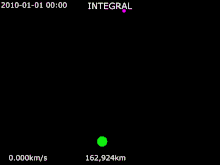INTEGRAL
The INTErnational Gamma-Ray Astrophysics Laboratory (INTEGRAL) is a space telescope for observing gamma rays of energies up to 8 MeV. It was launched by the European Space Agency (ESA) into Earth orbit in 2002, and is designed to provide imaging and spectroscopy of cosmic sources. In the MeV energy range, it is the most sensitive gamma ray observatory in space.[3] It is sensitive to higher energy photons than X-ray instruments such as NuSTAR, the Neil Gehrels SWIFT Observatory, XMM-Newton, and lower than other gamma-ray instruments such Fermi and HESS.
 Artist's impression of the INTEGRAL spacecraft | |||||||||||||||
| Mission type | Astronomy | ||||||||||||||
|---|---|---|---|---|---|---|---|---|---|---|---|---|---|---|---|
| Operator | ESA / RKA / NASA | ||||||||||||||
| COSPAR ID | 2002-048A | ||||||||||||||
| SATCAT no. | 27540 | ||||||||||||||
| Website | sci | ||||||||||||||
| Mission duration | 17 years, 9 months and 29 days elapsed | ||||||||||||||
| Spacecraft properties | |||||||||||||||
| Manufacturer | Alenia Spazio | ||||||||||||||
| Launch mass | ~ 4,000 kg (8,800 lb) | ||||||||||||||
| Dry mass | ~ 3,450 kg (7,610 lb) | ||||||||||||||
| Payload mass | ~ 2,000 kg (4,400 lb) | ||||||||||||||
| Dimensions | 5 m × 2.8 m × 3.2 m (16.4 ft × 9.2 ft × 10.5 ft) | ||||||||||||||
| Start of mission | |||||||||||||||
| Launch date | 17 October 2002, 01:33 UTC[1] | ||||||||||||||
| Rocket | Proton-K Blok-DM2 | ||||||||||||||
| Launch site | Baikonur 200/39 | ||||||||||||||
| Contractor | Roscosmos | ||||||||||||||
| Orbital parameters | |||||||||||||||
| Reference system | Geocentric | ||||||||||||||
| Regime | Highly elliptical | ||||||||||||||
| Semi-major axis | 87,941 kilometres (54,644 mi)[2] | ||||||||||||||
| Perigee altitude | 6,281.9 kilometres (3,903.4 mi)[2] | ||||||||||||||
| Apogee altitude | 156,859.1 kilometres (97,467.7 mi)[2] | ||||||||||||||
| Inclination | 54.0 degrees[2] | ||||||||||||||
| Period | 4,325.6 minutes[2] | ||||||||||||||
| Epoch | 27 January 2015, 17:47:58 UTC[2] | ||||||||||||||
| Main telescope | |||||||||||||||
| Type | Coded mask telescope | ||||||||||||||
| Diameter | 3.7 metres (12 ft) | ||||||||||||||
| Focal length | ~ 4 metres (13 ft) | ||||||||||||||
| Collecting area | 500 cm2 (78 sq in) (SPI, JEM-X) 3,100 cm2 (480 sq in) (IBIS) | ||||||||||||||
| Wavelengths | 15 keV to 10 MeV (main) 3 to 35 keV (JEM-X) 500 to 580 nm (OMC) | ||||||||||||||
| |||||||||||||||
 ESA astrophysics insignia for INTEGRAL | |||||||||||||||

Earth · INTEGRAL
Photons in INTEGRAL's energy range are emitted by relativistic and supra-thermal particles in violent sources, radioactivity from unstable isotopes produced during nucleosynthesis, X-ray binaries, and astronomical transients of all types, including gamma-ray bursts. The spacecraft's instruments have very wide fields of view, which is particularly useful for detecting gamma-ray emission from transient sources as they can continuously monitor large parts of the sky.
INTEGRAL is an ESA mission with additional contributions from European member states including Italy, France, Germany, and Spain. Cooperation partners are the Russian Space Agency with IKI and NASA.
Mission
Radiation more energetic than optical light, such as ultraviolet, X-rays, and gamma rays, and cannot penetrate Earth's atmosphere, direct observations must be made from space. INTEGRAL is an observatory, scientists can propose for observing time of their desired target regions, data are public after a proprietary period of up to one year.
INTEGRAL was launched from the Russian Baikonur spaceport, in Kazakhstan. The 2002 launch aboard a Proton-DM2 rocket achieved a 3-day elliptical orbit with an apogee of nearly 160,000 km and a perigee of above 2,000 km, hence mostly beyond radiation belts which would otherwise lead to high instrumental backgrounds from charged-particle activation. The spacecraft and instruments are controlled from ESOC in Darmstadt, Germany, ESA's control centre, through ground stations in Belgium (Redu) and California (Goldstone).
Fuel usage is much lower than predictions. INTEGRAL has far exceeded its 2+3-year planned lifetime, and is set to enter Earth atmosphere in 2029 as a definite end of the mission. Its orbit was adjusted in Jan/Feb 2015 to cause such a safe (southern) reentry, using half the remaining fuel then.
Spacecraft
The spacecraft body ("service module") is a copy of the XMM-Newton body. This saved development costs and simplified integration with infrastructure and ground facilities. (An adapter was necessary to mate with the different booster, though.) However, the denser instruments used for gamma rays and hard X-rays make INTEGRAL the heaviest scientific payload ever flown by ESA.
The body is constructed largely of composites. Propulsion is by a hydrazine monopropellant system, containing 544 kg of fuel in four exposed tanks. The titanium tanks were charged with gas to 24 bar (2.4 MPa) at 30 °C, and have tank diaphragms. Attitude control is via a star tracker, multiple Sun sensors, and multiple momentum wheels. The dual solar arrays, spanning 16 meters when deployed and producing 2.4 kW BoL, are backed up by dual nickel-cadmium battery sets.
The instrument structure ("payload module") is also composite. A rigid base supports the detector assemblies, and an H-shaped structure holds the coded masks approximately 4 meters above their detectors. The payload module can be built and tested independently from the service module, reducing cost.
Alenia Spazio (now Thales Alenia Space Italia) was the spacecraft prime contractor.
Instruments
Four instruments with large fields-of-view are co-aligned on this platform, to study a targets across such a wide energy range of almost two orders of magnitude in energy (other astronomy instruments in X-rays or optical cover much smaller ranges of factors of a few at most). Imaging is achieved by coded masks casting a shadowgram onto pixelised cameras; the tungsten masks were provided by the University of Valencia, Spain.
The INTEGRAL imager, IBIS (Imager on-Board the INTEGRAL Satellite) observes from 15 keV (hard X-rays) to 10 MeV (gamma rays). Angular resolution is 12 arcmin, enabling a bright source to be located to better than 1 arcmin. A 95 x 95 mask of rectangular tungsten tiles sits 3.2 meters above the detectors. The detector system contains a forward plane of 128 x 128 Cadmium-Telluride tiles (ISGRI- Integral Soft Gamma-Ray Imager), backed by a 64 x 64 plane of Caesium-Iodide tiles (PICsIT- Pixellated Caesium-Iodide Telescope). ISGRI is sensitive up to 1 MeV, while PICsIT extends to 10 MeV. Both are surrounded by passive shields of tungsten and lead. IBIS was provided by PI institutes in Rome/Italy and Paris/France.

The spectrometer aboard INTEGRAL is SPI, the SPectrometer of INTEGRAL. It was conceived and assembled by the French Space Agency CNES, with PI institutes in Toulouse/France and Garching/Germany. It observes radiation between 20 keV and 8 MeV. SPI has a coded mask of hexagonal tungsten tiles, above a detector plane of 19 germanium crystals (also packed hexagonally). The high energy resolution of 2 keV at 1 MeV is capable to resolve all candidate gamma-ray lines.The Ge crystals are actively cooled with a mechanical system of Stirling coolers to about 80K.
IBIS and SPI use active detectors to detect and veto charged particles that lead to background radiation. The SPI ACS (AntiCoincidence Shield) consists of a BGO scintillator blocks surrounding the camera and aperture, detecting all charged particles, and photons exceeding an energy of about 75 keV, that would hit the instrument from directions different from the aperture. A thin layer of plastic scintillator behind the tungsten tiles serves as additional charged-particle detector within the aperture.
The large effective area of the ACS turned out to be useful as an instrument in its own right. Its all-sky coverage and sensitivity make it a natural gamma-ray burst detector, and a valued component of the IPN (InterPlanetary Network).
Dual JEM-X units provide additional information on sources at soft and hard X-rays, from 3 to 35 keV. Aside from broadening the spectral coverage, imaging is more precise due to the shorter wavelength. Detectors are gas scintillators (xenon plus methane) in a microstrip layout, below a mask of hexagonal tiles.
INTEGRAL includes an Optical Monitor (OMC) instrument, sensitive from 500 to 580 nm. It acts as both a framing aid, and can note the activity and state of some brighter targets, e.g. it had been useful to monitor supernova light over months from SN2014J.
The spacecraft also includes a radiation monitor, INTEGRAL Radiation Environment Monitor (IREM), to note the orbital background for calibration purposes. IREM has an electron and a proton channel, though radiation up to cosmic rays can be sensed. Should the background exceed a preset threshold, IREM can shut down the instruments.
Scientific results
References
- "NASA - NSSDC - Spacecraft Details". NASA. Retrieved 2 February 2015.
- "INTEGRAL Satellite details 2002-048A NORAD 27540". N2YO. 2 February 2015. Retrieved 2 February 2015.
- Teegarden, B. J., Sturner, S. J. (April 1999). "INTEGRAL Observations of Gamma-Ray Bursts". American Astronomical Society, HEAD meeting #4, #17.01; Bulletin of the American Astronomical Society. 31: 717. Bibcode:1999HEAD....4.1701T.CS1 maint: multiple names: authors list (link)
See also
External links
- INTEGRAL at ESA
- INTEGRAL overview at CNES (French Space Agency)
- Integral operations page at ESA
- INTEGRAL at the ISDC (INTEGRAL Science Data Centre)
- INTEGRAL Mission Profile by NASA's Solar System Exploration
- NSSDC overview page
- SPI/INTEGRAL more information on SPI the spectrometer for INTEGRAL
- A Catalogue of INTEGRAL Sources INTEGRAL Sources identified through optical and near-infrared spectroscopy
.png)